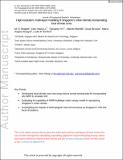| dc.contributor.author | Mughal, M. O. | |
| dc.contributor.author | Li, Xian‐Xiang | |
| dc.contributor.author | Yin, Tiangang | |
| dc.contributor.author | Martilli, Alberto | |
| dc.contributor.author | Brousse, Oscar | |
| dc.contributor.author | Dissegna, Maria Angela | |
| dc.contributor.author | Norford, Leslie K. | |
| dc.date.accessioned | 2022-02-15T19:57:50Z | |
| dc.date.available | 2022-02-15T19:57:50Z | |
| dc.date.issued | 2019-07-12 | |
| dc.identifier.issn | 2169-897X | |
| dc.identifier.issn | 2169-8996 | |
| dc.identifier.uri | https://hdl.handle.net/1721.1/140386 | |
| dc.description.abstract | We applied Weather Research and Forecasting (WRF) model's Multilayer Urban Canopy Model (MLUCM) to simulate the urban climate of Singapore during a hot period in April 2016. The high-resolution local climate zone (LCZ) map was used as urban land use/land cover data in order to study the intraurban variability in different LCZ classes. The LCZ map for Singapore was developed by adopting the World Urban Database and Access Portal Tools (WUDAPT) methodology based on satellite remote sensing imageries and building height data. The coupled WRF/MLUCM model was validated using meteorological data from stations across Singapore. Higher index of agreement compared to observations and lower root-mean-squared error of 2-m temperature, relative humidity, and global horizontal irradiance showed satisfactory model performance. A sensitivity analysis of initial and boundary conditions helped in determining the model configuration with the least error for quantifying the urban heat island (UHI) effect. The diurnal cycle and the spatial pattern of UHI were investigated, and it was found that the mean UHI intensity peaked in the early morning at 2.2 °C, reaching 3.6 °C in the Compact High Rise (LCZ1) areas. The anthropogenic heat due to indoor air conditioning was found to play a major role in all the processes studied, while the effect of the different land use types was most pronounced during nighttime and least visible near noon. The UHI circulation developed near the central catchment is found to prevent sea breezes from further propagating inland. | en_US |
| dc.language | en | |
| dc.publisher | American Geophysical Union (AGU) | en_US |
| dc.relation.isversionof | http://dx.doi.org/10.1029/2018jd029796 | en_US |
| dc.rights | Creative Commons Attribution-Noncommercial-Share Alike | en_US |
| dc.rights.uri | http://creativecommons.org/licenses/by-nc-sa/4.0/ | en_US |
| dc.source | Wiley | en_US |
| dc.title | High‐Resolution, Multilayer Modeling of Singapore's Urban Climate Incorporating Local Climate Zones | en_US |
| dc.type | Article | en_US |
| dc.identifier.citation | Mughal, M. O., Li, X.-X., Yin, T., Martilli, A., Brousse, O., Dissegna, M. A., & Norford, L. K. (2019). High-resolution, multilayer modeling of Singapore's urban climate incorporating local climate zones. Journal of Geophysical Research: Atmospheres, 124, 7764– 7785 | en_US |
| dc.contributor.department | Singapore-MIT Alliance in Research and Technology (SMART) | |
| dc.contributor.department | Massachusetts Institute of Technology. Department of Architecture | |
| dc.relation.journal | Journal of Geophysical Research: Atmospheres | en_US |
| dc.eprint.version | Author's final manuscript | en_US |
| dc.type.uri | http://purl.org/eprint/type/JournalArticle | en_US |
| eprint.status | http://purl.org/eprint/status/PeerReviewed | en_US |
| dspace.date.submission | 2022-02-10T17:39:49Z | |
| mit.journal.volume | 124 | en_US |
| mit.journal.issue | 14 | en_US |
| mit.license | OPEN_ACCESS_POLICY | |
| mit.metadata.status | Authority Work Needed | en_US |
